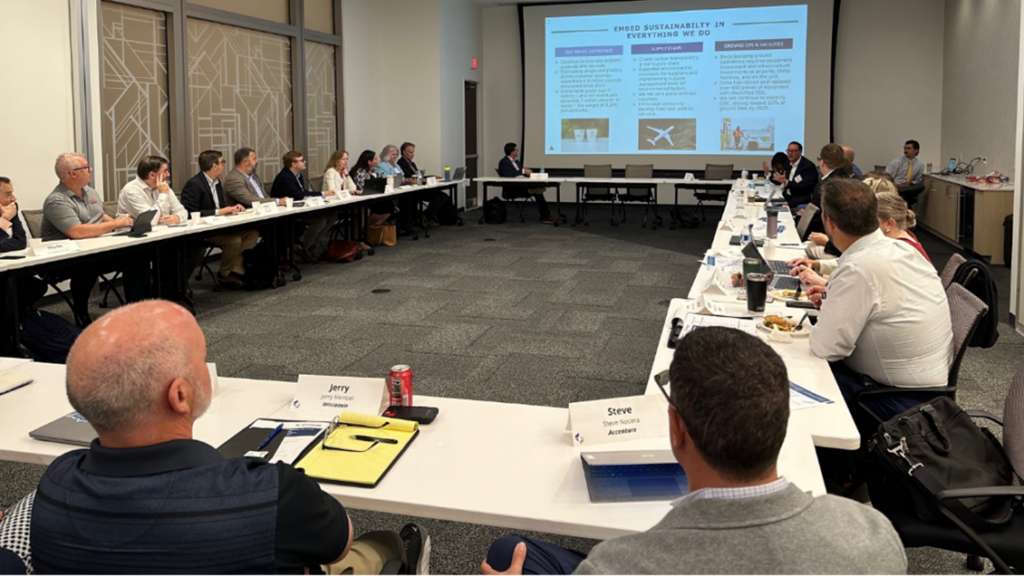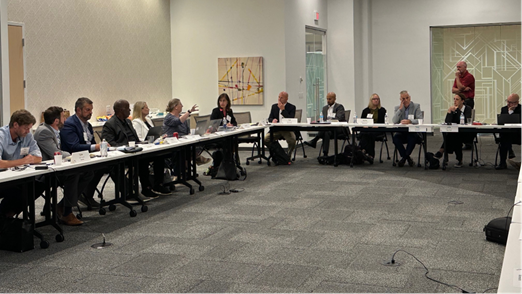On Tuesday July 30 and Wednesday July 31, 2024, NGA hosted the third of its Regional Project Delivery Workshops in Minneapolis, Minnesota. These workshops provide a forum for Governors’ advisors to discuss infrastructure project delivery and coordination challenges facing states and territories within a regional context. This third workshop was focused on Midwest states and was hosted in partnership with Minnesota Governor Tim Walz’s Office. This convening followed NGA’s first regional workshop in Nashville, Tennessee for Southeast states in November 2023 (you can find a read-out from the meeting here) and the second regional workshop for Northeast states held in Philadelphia, Pennsylvania in April 2024 (you can find that read-out here).

The agenda focused on four main infrastructure delivery topics: delivery of major bridge and highway projects; alternative financing and local engagement; the development of sustainable aviation fuel; and topics on the future of transportation. As with previous workshops, the convening was structured around facilitated discussions that were introduced by several speakers on each topic. This structure led to a robust dialogue over the course of the two days.
The meeting kicked off Tuesday afternoon with a welcome from the Minnesota team and an insightful introduction to the work of the Minnesota Department of Transportation. This was followed by a comprehensive presentation on the Blatnik Bridge Replacement Project, which involves the replacement of a critical link carrying I-535 over St Louis Bay between Duluth, Minnesota and Superior, Wisconsin. The presentation highlighted the need to pursue the project to replace a bridge nearing the end of its economic life, the importance of the connection for freight movement and the economy of the two states, the choice to deliver the project using a design-build procurement method, and the recent award of a $1.05 billion federal grant towards the project through the Infrastructure Investment and Jobs Act’s INFRA (Nationally Significant Multimodal Freight and Highway Projects) program. The presentation also emphasized close collaboration between Minnesota and Wisconsin on the project and the establishment of robust governance arrangements to oversee delivery.
This discussion on the Blatnik Bridge sparked a broader discussion within the room on project delivery challenges and opportunities associated with other major bridge and highway projects. Participants discussed insights from a range of other projects, including the Gordie Howe Bridge, which is a new international crossing linking Detroit, Michigan with Windsor, Canada; the Ohio River Bridges linking Indiana and Ohio; the replacement of the I-5 bridge connecting Oregon and Washington; progress of the Hudson River Tunnel projects between New York and New Jersey and the Indiana Toll Road, to name a few. These discussions explored a range of project delivery issues, including the range of delivery models, risk-allocation, workforce challenges, and industry engagement approaches.
During the rest of the afternoon, the discussion turned to alternative financing and local engagement issues. Oklahoma provided a detailed overview of their rural two-lane advancement and management plan (RAAMP), which is investing in the state’s rural highway network to reduce serious injuries and fatalities. They discussed how they were able to fast-track completion of the plan and reduce overall costs through alternative financing in the form of Transportation Infrastructure Finance and Innovation Act (TIFIA) loans through the Build America Bureau. The dialogue then turned to state engagement with local governments as they navigate and implement federal infrastructure funding opportunities. Participants discussed various approaches being adopted by states to support local jurisdictions in the delivery of infrastructure projects, including the availability of matching funds, technical assistance and agency support.

The second day of programming commenced with a discussion on sustainable aviation fuel – an alternative fuel made from non-petroleum feedstocks which can be blended at different levels with standard aviation fuel. Delta Airlines provided an overview of the company’s efforts to reach its goals of net zero emissions, including through supporting the development of sustainable aviation fuels. Delta discussed the need to build up both the supply and demand side of the market concurrently, as well as efforts being made at the state and federal level to support industry growth. The Greater MSP Partnership offered an overview of the Sustainable Aviation Fuel Hub, a collaboration which includes Greater MSP, Delta, Ecolab, Xcel Energy and Bank of America, which is aiming to build an industrial-scale value chain for sustainable aviation fuel anchored in Minnesota. These presentations encouraged a discussion in the room on the work of the Hub and how it could translate to other locations and sectors.
The workshop continued with a conversation on various topics associated with the future of transportation. The first topic focused on the use of existing rights of way to support multiple infrastructure assets, in the context of increasing demands on infrastructure and the need for rapid deployment. Minnesota Department of Transportation provided an overview of their exploration of utilizing highway rights of way for the siting of electricity transmission lines. This presentation discussed the increasing demand for electricity transmission assets, the rationale for potentially siting transmission in existing highway rights of way, and efforts to address regulatory and technical barriers to doing so. Minnesota passed legislation to allow co-location of new high-voltage transmission in all existing state and interstate highway corridors, embracing an initiative known as NextGen Highways. Other participants added their perspective on the issue, including how robust mapping can support better alignment of infrastructure and how highway rights of way can also be used for the deployment of other asset classes, including broadband middle mile infrastructure. The dialogue on the future of transportation then turned to the topic of integrating technology to improve highway operations and safety, which was anchored by a discussion on Cavnue’s pilot connected and automated vehicle corridor on a segment of I-94 in Michigan. The workshop wrapped up with the sharing of best practices on the deployment of electric vehicle charging infrastructure, and a reflection on the broader challenges and opportunities facing states and territories as they look to deliver major infrastructure projects in their jurisdictions.
NGA thanks Governor Walz’s team for all their contributions over the two-day event. NGA also thanks McKinsey for assisting us with finding office space for the event. We also express our appreciation for state participants, NGA Partners and other practitioners who all contributed to making the event such a success.












